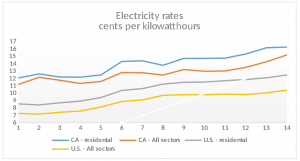Appears on Newsmax:
A draft package released by the Senate Finance Committee proposes to revive a 2.3 cent per kilowatt-hour production tax credit (PTC) incentive for wind energy, which lapsed last December. Congress had voted to terminate the PTC along with other tax breaks for wind projects at the end of 2013, only to have it retroactively extended through 2014 by the Obama cromnibus budget.
Previous “temporary helping hand” extensions have been granted seven times since PTC was first stablished in 1992 to “help the industry compete in the marketplace.” It was preceded by two other “temporary” federal subsidies dating back to 1978, which were advertised to accomplish the same elusive purpose.
Alas, despite lots of windy marketing claims there simply aren’t any free “renewable energy” lunches. According to the Energy Information Administration, 2013 PTC wind benefits alone topped $5.9 billion, while solar received $5.3 billion. The Senate Finance Committee now projects that a two-year PTC extension will heap on another $10.5 billion in lost federal tax revenues over the next 10 years.
Wind and solar combined provided less than 5 percent of total U.S. electricity in 2013. Yet according to the nonprofit Institute for Energy Research, federal subsidies and support on the basis of that per-unit electricity production, each of them received more than 50 times more subsidy support than coal and natural gas combined.
Added to this taxpayer pain are cost penalties borne by electricity consumers thanks to renewable energy mandates provided in 29 states and the District of Columbia that guarantee designated market shares regardless of extra production charges for wind and solar power. Escalating costs have prompted Ohio to freeze its mandates, and West Virginia to cancel them altogether.
Consider New York state, for example, which has been blowing billions of taxpayer green on wind, yet has some of the highest U.S. electricity rates. Despite this charity, a household there using 6,500 kwh of electricity annually will pay about $400 more than the national average. Statewide, this 53 percent extra cost over the national average amounts to approximately $3.2 billion each year. And after all, wasn’t the main idea to replace fossil-fueled plants with assuredly “cost-effective” renewables? A 2013 report by the New York Independent Systems Operator (NYISO) estimates that New York’s first 15 wind farms operating in 2010 produced about a 2.4 million megawatt-hour output.
That’s equivalent to a single 450 mwh gas-fired combined cycle generating unit operating only at 60 percent capacity which can be built at about one-fourth of the capital cost. Even worse, those wind turbines have a very short operating life, requiring a total infrastructure reinvestment about every 10-13 years, easily a $2 billion replacement for New York.
Add to this substantial infrastructure and transmission costs to deliver electricity from remote wind sites to the New York City area where greatest power demand exists. Such dislocations between locations of supply and high demand are typical throughout all regions of America, both for industrial scale wind and solar. The quality of that power isn’t any bargain either.
Unlike coal- and natural-gas-fired plants that provide reliable power when needed — including peak demand times — wind turbines only produce electricity intermittently as variable daily and seasonal weather conditions permit regardless of demand. That fickle output trend favors colder night-time periods rather than hot summer late afternoons when needed most.
The real kicker here is that wind has no real capacity value. Intermittent outputs require access to a “shadow capacity,” which enables utilities to balance power grids when wind conditions aren’t optimum . . . which is most of the time. What we don’t tend hear about is that those “spinning reserves” which equal total wind capacity are likely fueled by coal or natural gas which anti-fossil activists love to hate and wind was touted to replace. But then again, self-proclaimed environmentalists aren’t all keen on wind turbines either.
A Sierra Club official described them as giant “Cuisinarts in the sky” for bird and bat slaughters. In some cases “not in my backyard” resistance arises from an aesthetic perspective as evidenced, for example, by strong public opposition to the proposed 130-turbine offshore Cape Wind development stretching across 24 square miles of Nantucket Sound’s pristine Horseshoe Shoal. Other wind critics also have legitimate health concerns about land-based installations. Common symptoms include headaches, nausea, sleeplessness, and ringing in ears resulting from prolonged exposure to inaudibly low “infrasound” frequencies that penetrate walls.
So long as this industry’s survival depends upon preferential government handouts and regulatory mandates, two things are clear. Wind is not a free, or a competitive free market source of energy. It is also not a charity we can continue to afford blow money into. It’s time to finally pull the plug and permanently cut off the taxpayer and rate-payer juice.
